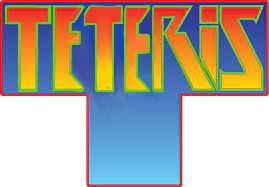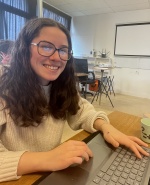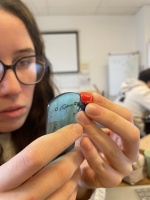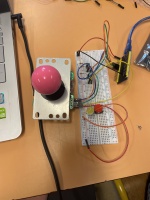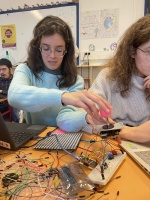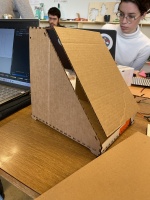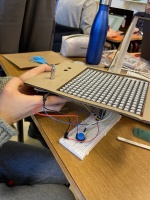ENIB 2024 : Tête’ris
Sommaire
- 1 description
- 2 Introduction
- 3 outil et matériel
- 4 fichiers à joindre
- 5 étapes de fabrication
- 6 Sources et documentation complémentaire
- 7 On oublies pas d'où on vient
description
La fine équipe
Jeanne Merceur, Solenn Perrin , Yuna Ligavan et Lou-Anne Cheneviere
Le principe est de concevoir en une journée un jeu d'arcade en arduino qui sera testé par des enfants.
Le jeu qui nous à été attribué est le TETRIS renommé TÊTERIS parceque, pourquoi pas ?
Les deux gros enjeux sont :
1) le jeu soit fonctionnel pour le 31 janvier à 14h30
2) le jeu donne envie aux enfants
Introduction
Le principe du TÊTERIS
Manipuler des formes géométriques pour créer des lignes pleines. Une fois la ligne ( horizontale) pleine, elle se détruit et le joueur gagne des points. Le jeu devient de plus en plus rapide Le but est donc de survivre le plus longtemps possible.
outil et matériel
Arduino MEGA: https://ebay.to/2PcjynB
WS2812 LED strip: https://ebay.to/2Zr4NNA
7-segment display module: https://ebay.to/2zhCkze
5V power supply: https://ebay.to/2Zf2phN
DFplayer: https://ebay.to/340YwvR
On/Off switch: https://ebay.to/2Ntge51
Buttons: https://ebay.to/30xHumy
Joystick: https://ebay.to/2ZnAM1a
Small speaker: https://ebay.to/2HmaOoQ
Wire: https://ebay.to/31Zj9q9
fichiers à joindre
code, ficher d'impression 3D, de découpe laser ou vinyle, ...
El famoso le code Arduino
<syntaxhighlight lang="Arduino" line>
- include <Adafruit_NeoPixel.h> //Downlaod here: https://electronoobs.com/eng_arduino_Adafruit_NeoPixel.php
- include "EEPROMAnything.h" //module créé par le créateur du code
- include <SoftwareSerial.h>
- include <DFMiniMp3.h>
- include "pitches.h"
// size of the LED grid
- define GRID_W (16)//taille de la plaque de led
- define GRID_H (16)
- define STRAND_LENGTH (GRID_W*GRID_H)
- define LED_DATA_PIN (16)//pin des led : 16
// did you wire your grid in an 'S' instead of a 'Z'? change this value to 0.
- define BACKWARDS (0)
// max size of each tetris piece
- define PIECE_W (4)
- define PIECE_H (4)
// how many kinds of pieces
- define NUM_PIECE_TYPES (7)
// gravity options
- define DROP_MINIMUM (20) // top speed gravity can reach
- define DROP_ACCELERATION (15) // how fast gravity increases
- define INITIAL_MOVE_DELAY (100)
- define INITIAL_DROP_DELAY (500)
- define INITIAL_DRAW_DELAY (30)
//Inputs/outputs
- define MAX7219_Data_IN 15
- define MAX7219_Chip_Select 4
- define MAX7219_Clock 5
//pin defining int button_left = 12; int button_right = 14; int button_up = 27; int button_down = 26; int button_pause = 25; int button_start = 33;
//define new variables byte adr = 0x08; byte num = 0x00; int i = 0; int top_score = 0; int score = 0; int top_score_1 = 0; int top_score_2 = 0; int top_score_3 = 0; int top_score_4 = 0; int score_1 = 0; int score_2 = 0; int score_3 = 0; int score_4 = 0; bool Pause = false; bool pause_onece = false; bool pause_pressed = false; unsigned long previousMillis = 0; unsigned long currentMillis = 0;
// 1 color drawings of each piece in each rotation. // Each piece is max 4 wide, 4 tall, and 4 rotations. // création const char piece_I[] = {
0,0,0,0, 1,1,1,1, 0,0,0,0, 0,0,0,0,
0,0,1,0, 0,0,1,0, 0,0,1,0, 0,0,1,0, 0,0,0,0, 0,0,0,0, 1,1,1,1, 0,0,0,0,
0,1,0,0, 0,1,0,0, 0,1,0,0, 0,1,0,0,
};
const char piece_L[] = {
0,0,1,0, 1,1,1,0, 0,0,0,0, 0,0,0,0, 0,1,0,0, 0,1,0,0, 0,1,1,0, 0,0,0,0,
0,0,0,0, 1,1,1,0, 1,0,0,0, 0,0,0,0, 1,1,0,0, 0,1,0,0, 0,1,0,0, 0,0,0,0,
};
const char piece_J[] = {
1,0,0,0, 1,1,1,0, 0,0,0,0, 0,0,0,0, 0,1,1,0, 0,1,0,0, 0,1,0,0, 0,0,0,0,
0,0,0,0, 1,1,1,0, 0,0,1,0, 0,0,0,0, 0,1,0,0, 0,1,0,0, 1,1,0,0, 0,0,0,0,
};
const char piece_T[] = {
0,1,0,0, 1,1,1,0, 0,0,0,0, 0,0,0,0,
0,1,0,0, 0,1,1,0, 0,1,0,0, 0,0,0,0, 0,0,0,0, 1,1,1,0, 0,1,0,0, 0,0,0,0,
0,1,0,0, 1,1,0,0, 0,1,0,0, 0,0,0,0,
};
const char piece_S[] = {
0,1,1,0, 1,1,0,0, 0,0,0,0, 0,0,0,0,
0,1,0,0, 0,1,1,0, 0,0,1,0, 0,0,0,0,
0,0,0,0, 0,1,1,0, 1,1,0,0, 0,0,0,0,
1,0,0,0, 1,1,0,0, 0,1,0,0, 0,0,0,0,
};
const char piece_Z[] = {
1,1,0,0, 0,1,1,0, 0,0,0,0, 0,0,0,0, 0,0,1,0, 0,1,1,0, 0,1,0,0, 0,0,0,0,
0,0,0,0, 1,1,0,0, 0,1,1,0, 0,0,0,0, 0,1,0,0, 1,1,0,0, 1,0,0,0, 0,0,0,0,
};
const char piece_O[] = {
1,1,0,0, 1,1,0,0, 0,0,0,0, 0,0,0,0, 1,1,0,0, 1,1,0,0, 0,0,0,0, 0,0,0,0, 1,1,0,0, 1,1,0,0, 0,0,0,0, 0,0,0,0, 1,1,0,0, 1,1,0,0, 0,0,0,0, 0,0,0,0,
};
// An array of pointers! // liste des pièces créées const char *pieces[NUM_PIECE_TYPES] = {
piece_S, piece_Z, piece_L, piece_J, piece_O, piece_T, piece_I,
};
// couleurs disponibles pour les pièces const long piece_colors[NUM_PIECE_TYPES] = {
0x009900, // green S 0xFF0000, // red Z 0xFF8000, // orange L 0x0000CC, // blue J 0xFFFF00, // yellow O 0xFF00FF, // purple T 0x00FFFF, // cyan I
};
Adafruit_NeoPixel strip = Adafruit_NeoPixel(STRAND_LENGTH, LED_DATA_PIN, NEO_RGB + NEO_KHZ800);
// this is how arduino remembers what the button was doing in the past, // so arduino can tell when it changes. int old_button=0; // so arduino can tell when user moves sideways int old_px = 0; // so arduino can tell when user tries to turn int old_i_want_to_turn=0; //Function to shift data on the 7 segment module
// this is how arduino remembers the falling piece. int piece_id; int piece_rotation; int piece_x; int piece_y;
// the bag from which new pieces are grabbed. // the bag is only refilled when all pieces are taken. // this guarantees a maximum of 12 moves between two Is // or four S & Z in a row. char piece_sequence[NUM_PIECE_TYPES]; char sequence_i=NUM_PIECE_TYPES;
// this controls how fast the player can move. long last_move; long move_delay=100;
// this controls when the piece automatically falls. long last_drop; long drop_delay;
long last_draw; long draw_delay; // 60 fps
// this is how arduino remembers where pieces are on the grid. long grid[GRID_W*GRID_H];
// I want to turn on point P(x,y), which is X from the left and Y from the top. // I might also want to hold it on for us microseconds. void p(int x,int y,long color) {
int a = (GRID_H-1-y)*GRID_W;
if( ( y % 2 ) == BACKWARDS ) { // % is modulus.
// y%2 is false when y is an even number - rows 0,2,4,6.
a += x;
} else {
// y%2 is true when y is an odd number - rows 1,3,5,7.
a += GRID_W - 1 - x;
}
a%=STRAND_LENGTH;
strip.setPixelColor(a,color);
}
// grid contains the arduino's memory of the game board, including the piece that is falling. void draw_grid() {
int x, y;
for(y=0;y<GRID_H;++y) {
for(x=0;x<GRID_W;++x) {
if( grid[y*GRID_W+x] != 0 ) {
p(x,y,grid[y*GRID_W+x]);
} else {
p(x,y,0);
}
}
}
strip.setBrightness(1);
strip.show();
}
// choose a new piece from the sequence. // the sequence is a random list that contains one of each piece. // that way you're guaranteed an even number of pieces over time, // tho the order is random. void choose_new_piece() {
if( sequence_i >= NUM_PIECE_TYPES ) {
// list exhausted
int i,j, k;
for(i=0;i<NUM_PIECE_TYPES;++i) {
do {
// pick a random piece
j = rand() % NUM_PIECE_TYPES;
// make sure it isn't already in the sequence.
for(k=0;k<i;++k) {
if(piece_sequence[k]==j) break; // already in sequence
}
} while(k<i);
// not in sequence. Add it.
piece_sequence[i] = j;
}
// rewind sequence counter
sequence_i=0;
}
// get the next piece in the sequence.
piece_id = piece_sequence[sequence_i++];
// always start the piece top center.
piece_y=-4; // -4 squares off the top of the screen.
piece_x=3;
// always start in the same orientation.
piece_rotation=0;
}
void erase_piece_from_grid() {
int x, y;
const char *piece = pieces[piece_id] + (piece_rotation * PIECE_H * PIECE_W);
for(y=0;y<PIECE_H;++y) {
for(x=0;x<PIECE_W;++x) {
int nx=piece_x+x;
int ny=piece_y+y;
if(ny<0 || ny>GRID_H) continue;
if(nx<0 || nx>GRID_W) continue;
if(piece[y*PIECE_W+x]==1) {
grid[ny*GRID_W+nx]=0; // zero erases the grid location.
}
}
}
}
void add_piece_to_grid() {
int x, y;
const char *piece = pieces[piece_id] + (piece_rotation * PIECE_H * PIECE_W);
for(y=0;y<PIECE_H;++y) {
for(x=0;x<PIECE_W;++x) {
int nx=piece_x+x;
int ny=piece_y+y;
if(ny<0 || ny>GRID_H) continue;
if(nx<0 || nx>GRID_W) continue;
if(piece[y*PIECE_W+x]==1) {
grid[ny*GRID_W+nx]=piece_colors[piece_id]; // zero erases the grid location.
}
}
}
}
// Move everything down 1 space, destroying the old row number y in the process.
void delete_row(int y) {
score = score + 10;
if(score > top_score)
{
EEPROM_writeAnything(1, score);
}
EEPROM_readAnything(1,top_score);
top_score_1 = top_score - ( ( top_score/10 ) * 10 );
top_score_2 = ((top_score - ( ( top_score/100 ) * 100 )) - top_score_1)/10;
top_score_3 = ((top_score - ( ( top_score/1000 ) * 1000 )) - top_score_1 - top_score_2)/100;
top_score_4 = (top_score - top_score_1 - top_score_2 - top_score_3) / 1000;
score_1 = score - ( ( score/10 ) * 10 );
score_2 = ((score - ( ( score/100 ) * 100 )) - score_1)/10;
score_3 = ((score - ( ( score/1000 ) * 1000 )) - score_1 - score_2)/100;
score_4 = (score - score_1 - score_2 - score_3) / 1000;
shift(0x08, score_4); //digit 7 (leftmost digit) data
shift(0x07, score_3);
shift(0x06, score_2);
shift(0x05, score_1);
shift(0x04, top_score_4);
shift(0x03, top_score_3);
shift(0x02, top_score_2);
shift(0x01, top_score_1); //digit 0 (rightmost digit) data
int x;
for(;y>0;--y) {
for(x=0;x<11;++x) {
grid[y*GRID_W+x] = grid[(y-1)*GRID_W+x];
}
}
// everything moved down 1, so the top row must be empty or the game would be over.
for(x=0;x<GRID_W;++x) {
grid[x]=0;
}
} void fall_faster() {
if(drop_delay > DROP_MINIMUM) drop_delay -= DROP_ACCELERATION;
}
// permet de retirer les lignes complétées par le joueur void remove_full_rows() {
int x, y, c;
char row_removed=0;
for(y=0;y<GRID_H;++y) {
// count the full spaces in this row
c = 0;
for(x=0;x<GRID_W;++x) {
if( grid[y*GRID_W+x] > 0 ) c++;
}
if(c>=11) {
// row full!
delete_row(y);
fall_faster();
}
}
}
// essayer de déplacer la pièce a gauche (left) ou à droite (right) int old_button_left = 0; int old_button_right = 0;
void try_to_move_piece_sideways() {
if (digitalRead(button_left) && !old_button_left) {
delay(50); // Ajoutez une petite temporisation ici
if (digitalRead(button_left)) { // Vérifiez à nouveau après la temporisation
if (piece_can_fit(piece_x + 1, piece_y, piece_rotation) == 1) {
piece_x += 1;
}
}
}
old_button_left = digitalRead(button_left);
if (digitalRead(button_right) && !old_button_right) {
delay(50); // Ajoutez une petite temporisation ici
if (digitalRead(button_right)) { // Vérifiez à nouveau après la temporisation
if (piece_can_fit(piece_x - 1, piece_y, piece_rotation) == 1) {
piece_x -= 1;
}
}
}
old_button_right = digitalRead(button_right);
}
// essayer de faire tourner la pièce, avec le joystick haut
void try_to_rotate_piece() {
int i_want_to_turn=0;
// what does the joystick button say
int new_button = !digitalRead(button_up);
// if the button state has just changed AND it is being let go,
if( new_button > 0 && old_button != new_button ) {
i_want_to_turn=1;
}
old_button=new_button;
if(i_want_to_turn==1 && i_want_to_turn != old_i_want_to_turn) {
// figure out what it will look like at that new angle
int new_pr = ( piece_rotation + 1 ) % 4;
// if it can fit at that new angle (doesn't bump anything)
if(piece_can_fit(piece_x,piece_y,new_pr)) {
// then make the turn.
piece_rotation = new_pr;
} else {
// wall kick
if(piece_can_fit(piece_x-1,piece_y,new_pr)) {
piece_x = piece_x-1;
piece_rotation = new_pr;
} else if(piece_can_fit(piece_x+1,piece_y,new_pr)) {
piece_x = piece_x+1;
piece_rotation = new_pr;
}
}
}
old_i_want_to_turn = i_want_to_turn;
}
//verifie si la pièce peut aller au prochain endroit prévu int piece_can_fit(int px,int py,int pr) {
if( piece_off_edge(px,py,pr) ) return 0; if( piece_hits_rubble(px,py,pr) ) return 0; return 1;
}
//verifie que la pièce ne se déplace pas à l'extérieur de la grille int piece_off_edge(int px,int py,int pr) {
int x,y;
const char *piece = pieces[piece_id] + (pr * PIECE_H * PIECE_W);
for(y=0;y<PIECE_H;++y) {
for(x=0;x<PIECE_W;++x) {
int nx=px+x;
int ny=py+y;
if(ny<0) continue; // off top, don't care
if(piece[y*PIECE_W+x]>0) {
if(nx<0)return 1; // yes: off left side
if(nx>=11 ){return 1;} // yes: off right side, 11=taille de la grille du jeu
}
}
}
return 0; // inside limits
}
//verifie si la pièce tape le fond de la grille ou si elle tape une autre pièce int piece_hits_rubble(int px,int py,int pr) {
int x,y;
const char *piece = pieces[piece_id] + (pr * PIECE_H * PIECE_W);
for(y=0;y<PIECE_H;++y) {
int ny=py+y;
if(ny<0) continue;
for(x=0;x<PIECE_W;++x) {
int nx=px+x;
if(piece[y*PIECE_W+x]>0) {
if(ny>=GRID_H ) return 1; // yes: goes off bottom of grid
if(grid[ny*GRID_W+nx]!=0 ) return 1; // yes: grid already full in this space
}
}
}
return 0; // doesn't hit
}
void draw_restart()
{
for(int i=0;i<STRAND_LENGTH;i++)
{
// pixels.Color takes RGB values, from 0,0,0 up to 255,255,255
strip.setPixelColor(i, strip.Color(0,0,0)); // Moderately bright green color.
}
strip.setPixelColor(55, strip.Color(150,150,150)); strip.setPixelColor(74, strip.Color(150,150,150)); strip.setPixelColor(77, strip.Color(150,150,150)); strip.setPixelColor(83, strip.Color(150,150,150)); strip.setPixelColor(85, strip.Color(150,150,150)); strip.setPixelColor(90, strip.Color(150,150,150)); strip.setPixelColor(91, strip.Color(150,150,150)); strip.setPixelColor(92, strip.Color(150,150,150)); strip.setPixelColor(93, strip.Color(150,150,150)); strip.setPixelColor(98, strip.Color(150,150,150)); strip.setPixelColor(101, strip.Color(150,150,150)); strip.setPixelColor(106, strip.Color(150,150,150)); strip.setPixelColor(107, strip.Color(150,150,150)); strip.setPixelColor(108, strip.Color(150,150,150)); strip.setPixelColor(109, strip.Color(150,150,150)); strip.show(); // This sends the updated pixel color to the hardware.
/*if(!pause_onece)
{
mp3.playMp3FolderTrack(2);
pause_onece = true;
delay(1000);
}*/
}
void all_white() {
for(int i=0;i<STRAND_LENGTH;i++){
// pixels.Color takes RGB values, from 0,0,0 up to 255,255,255 strip.setPixelColor(i, strip.Color(120,120,120)); // Moderately bright green color. strip.show(); // This sends the updated pixel color to the hardware. delay(3); // Delay for a period of time (in milliseconds). }
}
void game_over() {
score = 0; /*mp3.playMp3FolderTrack(4); // engine start + submarine sound*/ game_over_loop_leds(); delay(1000); int x,y;
long over_time = millis();
draw_restart();
currentMillis = millis();
previousMillis = currentMillis;
int led_number = 1;
while(millis() - over_time < 8000) {
currentMillis = millis();
if(currentMillis - previousMillis >= 1000){
previousMillis += 1000;
strip.setPixelColor(55-led_number, strip.Color(150,150,150));
strip.show();
led_number += 1;
}
// click the button?
if(!digitalRead(button_start)) {
// restart!
/*mp3.playMp3FolderTrack(3); // engine start + submarine sound*/
all_white();
delay(400);
break;
}
}
/*mp3.playMp3FolderTrack(3); // engine start + submarine sound*/
all_white();
setup();
return;
}
void game_over_loop_leds()
{
for(int i=0;i<STRAND_LENGTH;i++){
// pixels.Color takes RGB values, from 0,0,0 up to 255,255,255 strip.setPixelColor(i, strip.Color(0,150,0)); // Moderately bright green color.
strip.show(); // This sends the updated pixel color to the hardware.
delay(10); // Delay for a period of time (in milliseconds).
}
}
void try_to_drop_piece() {
erase_piece_from_grid();
if(piece_can_fit(piece_x,piece_y+1,piece_rotation)) {
piece_y++; // move piece down
add_piece_to_grid();
} else {
// hit something!
// put it back
add_piece_to_grid();
remove_full_rows();
if(game_is_over()==1) {
game_over();
}
// game isn't over, choose a new piece
choose_new_piece();
}
}
void try_to_drop_faster() {
if(digitalRead(button_down))
{
try_to_drop_piece();
}
}
void react_to_player() {
erase_piece_from_grid(); try_to_move_piece_sideways(); try_to_rotate_piece(); add_piece_to_grid(); try_to_drop_faster();
}
// can the piece fit in this new location
int game_is_over() {
int x,y;
const char *piece = pieces[piece_id] + (piece_rotation * PIECE_H * PIECE_W);
for(y=0;y<PIECE_H;++y) {
for(x=0;x<PIECE_W;++x) {
int ny=piece_y+y;
int nx=piece_x+x;
if(piece[y*PIECE_W+x]>0) {
if(ny<0) return 1; // yes: off the top!
}
}
}
return 0; // not over yet...
}
void shift(byte send_to_address, byte send_this_data)
{
digitalWrite(MAX7219_Chip_Select, LOW); shiftOut(MAX7219_Data_IN, MAX7219_Clock, MSBFIRST, send_to_address); shiftOut(MAX7219_Data_IN, MAX7219_Clock, MSBFIRST, send_this_data); digitalWrite(MAX7219_Chip_Select, HIGH);
} void setup() {
Serial.begin(115200); /*mp3.begin();*/ /*uint16_t volume = mp3.getVolume(); mp3.setVolume(30); uint16_t count = mp3.getTotalTrackCount(); delay(1000); mp3.playMp3FolderTrack(1);*/// engine start + submarine sound //EEPROM_writeAnything(1, 000);
//définir les pins pinMode(MAX7219_Data_IN, OUTPUT); pinMode(MAX7219_Chip_Select, OUTPUT); pinMode(MAX7219_Clock, OUTPUT); digitalWrite(MAX7219_Clock, HIGH);
//définir les pins pour chaque bouton pinMode(button_pause,INPUT); pinMode(button_start,INPUT); pinMode(button_left,INPUT); pinMode(button_right,INPUT); pinMode(button_up,INPUT); pinMode(button_down,INPUT); delay(1);
//Setup shift(0x0f, 0x00); //display test register - test mode off shift(0x0c, 0x01); //shutdown register - normal operation shift(0x0b, 0x07); //scan limit register - display digits 0 thru 7 shift(0x0a, 0x0f); //intensity register - max brightness shift(0x09, 0xff); //decode mode register - CodeB decode all digits EEPROM_readAnything(1,top_score);
Serial.println(top_score); top_score_1 = top_score - ( ( top_score/10 ) * 10 ); top_score_2 = ((top_score - ( ( top_score/100 ) * 100 )) - top_score_1)/10; top_score_3 = ((top_score - ( ( top_score/1000 ) * 1000 )) - top_score_1 - top_score_2)/100; top_score_4 = (top_score - top_score_1 - top_score_2 - top_score_3) / 1000; shift(0x08, 0x0f); //digit 7 (leftmost digit) data shift(0x07, 0x0f); shift(0x06, 0x0f); shift(0x05, 0x0f); shift(0x04, top_score_4); shift(0x03, top_score_3); shift(0x02, top_score_2); shift(0x01, top_score_1); //digit 0 (rightmost digit) data
int i; // setup the LEDs strip.begin(); strip.setBrightness(1); strip.show(); // Initialize all pixels to 'off'
// make sure arduino knows the grid is empty.
for(i=0;i<GRID_W*GRID_H;++i) {
grid[i]=0;
}
// make the game a bit more random - pull a number from space and use it to 'seed' a crop of random numbers.
randomSeed(analogRead(4)+analogRead(2)+analogRead(3));
// get ready to start the game.
choose_new_piece();
move_delay=INITIAL_MOVE_DELAY;
drop_delay=INITIAL_DROP_DELAY;
draw_delay=INITIAL_DRAW_DELAY;
// start the game clock after everything else is ready. last_draw = last_drop = last_move = millis();
}
//Void used for sound pause
void waitMilliseconds(uint16_t msWait)
{
uint32_t start = millis();
while ((millis() - start) < msWait)
{
// calling mp3.loop() periodically allows for notifications
// to be handled without interrupts
/*mp3.loop();*/
delay(1);
}
} //modifie les LED pour le mode pause void draw_pause() {
for(int i=0;i<STRAND_LENGTH;i++)
{
// pixels.Color takes RGB values, from 0,0,0 up to 255,255,255
strip.setPixelColor(i, strip.Color(0,0,0)); // Moderately bright green color.
}
strip.setPixelColor(53, strip.Color(150,150,150));
strip.setPixelColor(58, strip.Color(150,150,150));
strip.setPixelColor(66, strip.Color(150,150,150));
strip.setPixelColor(67, strip.Color(150,150,150));
strip.setPixelColor(68, strip.Color(150,150,150));
strip.setPixelColor(69, strip.Color(150,150,150));
strip.setPixelColor(74, strip.Color(150,150,150));
strip.setPixelColor(77, strip.Color(150,150,150));
strip.setPixelColor(82, strip.Color(150,150,150));
strip.setPixelColor(83, strip.Color(150,150,150));
strip.setPixelColor(84, strip.Color(150,150,150));
strip.setPixelColor(85, strip.Color(150,150,150));
strip.setBrightness(1);
strip.show(); // This sends the updated pixel color to the hardware.
if(!pause_onece)
{
/*mp3.playMp3FolderTrack(2); // engine start + submarine sound*/
pause_onece = true;
delay(1000);
}
}
// called over and over after setup() void loop() {
long t = millis();
if(!Pause)
{
if(!digitalRead(button_pause) && !pause_pressed)
{
Pause = !Pause;
pause_pressed = true;
pause_onece = false;
}
if(digitalRead(button_pause) && pause_pressed)
{
pause_pressed = false;
}
// the game plays at one speed,
if(t - last_move > move_delay ) {
last_move = t;
react_to_player();
}
// ...and drops the falling block at a different speed.
if(t - last_drop > drop_delay ) {
last_drop = t;
try_to_drop_piece();
}
// when it isn't doing those two things, it's redrawing the grid.
if(t - last_draw > draw_delay ) {
last_draw = t;
draw_grid();
}
}//end of !pause
else
{
if(!digitalRead(button_pause) && !pause_pressed)
{
Pause = !Pause;
pause_pressed = true;
/*mp3.playMp3FolderTrack(1); // engine start + submarine sound*/
}
if(digitalRead(button_pause) && pause_pressed)
{
pause_pressed = false;
}
draw_pause();
delay(1);
}
}
étapes de fabrication
étape 1: le visuel
L'idée : Faire une borne d'alcade
Dessins papier :
Dessin en modélisation 3D : test d'une visualisation sur CATIA mais pas très concluant puis pas hyper utile pour découpe laser sur du bois...
Nous nous sommes donc rendu sur le site ... pour trouver un plan de boite d'arcade avec des plans pour la découpe laser !
C'est tout de suite bien plus concluant donc nous avons fait des test pour les dimensions, le maintient, etc avec du carton !
étape 2: le fonctionnement de l'arduino
Comprendre le fonctionnement des composants
une fois que les composants ont été compris et que nous pouvons les réutiliser, nous commencons a developper le code principale dédié au fonctionnement général du jeu
étape 3 : amélioration du code
Une fois le code principal crée, nous avons observer des dysfonctionnement mineurs mais nécessitant l’amélioration du code.
étape 3: la maquette
étape 4: découpe laser
étape 5: soudure des composants électroniques
étape 6: assemblage entre la structure et le jeu
troubleshouting
conception du visuel
Nous avions une première idée de design type arcade vintage, mais le design était trop grand, la consommation de ressources aurait été trop importante, et la découpe laser n’était même pas envisageable, nous avons donc du changer de projet concernant la présentation...
code
Nous sommes resté bloqués sur plusieurs dysfonctionnement, le bloc à guider se déplaçait systématiquement à la fin (avant que le bloc se dépose). Également nous avons rencontrés des difficulté pour faire disparaitre les lignes pleines pendant la partie, le jeu se met en pause de manière aléatoire.
Pour avancé malgré les difficulté nous avons pu faire appel à nos accompagnateurs, chercher sur internet des solutions ou encore s'aider de chat GPT.
Sources et documentation complémentaire
- le tuto <3
- https://www.youtube.com/watch?v=3FmxySApcyQ
- Marginally Celver source code: https://www.marginallyclever.com/2015...
- Tutorial website: https://electronoobs.com/eng_arduino_...
- https://knowledge.parcours-performance.com/affichage-7-segments-cher-arduino/

